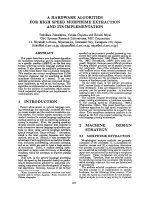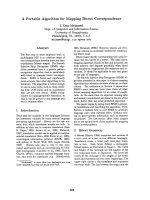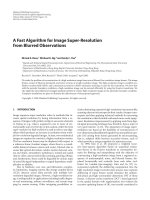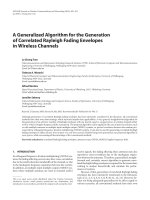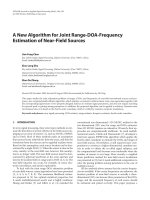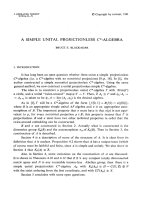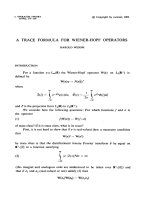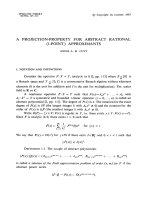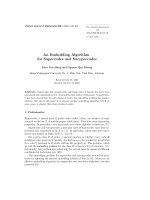Báo cáo toán học: "A simple algorithm for constructing Szemer´di’s Regularity Partition e" pps
Bạn đang xem bản rút gọn của tài liệu. Xem và tải ngay bản đầy đủ của tài liệu tại đây (122.75 KB, 7 trang )
A simple algorithm for constructing
Szemer´edi’s Regularity Partition
Alan Frieze
Department of Mathematical Sciences,
Carnegie Mellon University.
∗
Ravi Kannan
Department of Computer Science,
Yale University.
†
Submitted: November 25, 1998; Accepted: March 15, 1999.
Abstract
We give a simple constructive version of Szemer´edi’s Regularity
Lemma, based on the computation of singular values of matrices.
Mathematical Reviews Subject Numbers: 05C85, 68R10.
1 Introduction
“Szemer´edi’s Regularity Lemma [9] is one of the most powerful tools of (ex-
tremal) graph theory”. One can only agree with that opening sentence of the
∗
Supported in part by NSF grant CCR-9530974.
†
Supported in part by NSF grant CCR-9528973.
1
the electronic journal of combinatorics 6 (1999), #R17 2
paper by Koml´os and Simonovits [6]. It has many, many applications and
we refer the reader to this excellent survey.
The Regularity lemma is often used to prove the existence of certain objects
and if in addition one wants to construct them, then one needs a constructive
version of the lemma. This was provided by Alon, Duke, Lefmann, R¨odl and
Yuster [1]. Subsequently, Frieze and Kannan [3, 4] gave a different version
and extended it to deal with hypergraphs, (see also Czygrinow and R¨odl [2]).
In this note, we give another construction based on the construction of sin-
gular values of matrices. The proofs in [1, 3, 4] are somewhat technical.
The result of this paper follows quite easily from a simple lemma relating
non-regularity and largeness of singular values.
1.1 Szemer´edi’s Lemma
Let G =(V,E) be a graph with n vertices and let A be its adjacency matrix.
For a disjoint pair of subsets A, B ⊆ V let e(A, B) denote the number of
edges between A and B.Thedensity d(A, B) is defined by
d(A, B)=
e(A, B)
|A||B|
.
A disjoint pair A, B ⊆ V is said to be − regular if for every X ⊆ A with
|X|≥|A| and Y ⊆ B with |Y |≥|B|,wehave
|d(X,Y ) −d(A, B) |≤.
Theorem 1 (Szemer´edi’s Regularity Lemma) For every >0 and in-
teger m>0 there are integers P(, m),Q(, m) with the following property:
for every graph G =(V, E) with n ≥ P(, m) vertices there is a partition P
of V into k +1classes V
0
,V
1
, ,V
k
such that
• m ≤ k ≤ Q(, m).
•|V
1
| = |V
2
| = ···= |V
k
|.
• All but at most k
2
of the pairs (V
i
,V
j
) are -regular.
•|V
0
|≤n.
the electronic journal of combinatorics 6 (1999), #R17 3
A partition satisfying the second criterion is called equitable. V
0
is called the
exceptional class.
Following [9], for every equitable partition P into k +1classes we definea
number called the index of P.
ind(P)=
1
k
2
1≤r,s≤k
d(V
i
,V
j
)
2
.
A crucial lemma proved in [9] and stated in the following form in [1] states:
Lemma 1 Fix k and γ and let G =(V, E) be a graph with n vertices. Let
P be an equitable partition of V into classes V
0
,V
1
, ,V
k
. Assume |V
1
| >
4
2k
and 4
k
> 600γ
−2
. Given proofs that more than γk
2
pairs (V
r
,V
s
) are
not γ-regular (where by proofs we mean subsets X = X(r, s) ⊆ V
r
,Y =
Y (r, s)=⊆ V
s
that violate the γ-regularity of (V
r
,V
s
))wecanfindinO(n)
time an equitable partition P
(which is a refinement of P) into 1+k4
k
classes, with an exceptional class of cardinality at most
|V
0
|+ n/4
k
and such that
ind(P
) ≥ ind(P)+γ
5
/20.
We first describe a procedure for finding a proof that a pair is not γ-regular;
this will be the central part. Then we complete the algorithm with this
procedureonhandusingtheabovelemma.
1.2 Singular Values
An m × n matrix A has a Singular Value Decomposition into the sum of
rank one matrices, see for example Golub and Van Loan [5]. It has many
important applications. The first singular value σ
1
is defined as
σ
1
(A)= max
|x|=|y|=1
|x
T
Ay|.
This value can be computed with high accuracy in polynomial time [5]. It is
the square root of the largest eigenvalue of A
T
A.
For the following lemma, W is a p × q matrix with rows indexed by R,
columns indexed by C.Weassumethat||W||
∞
=max
i∈R,j∈C
|W(i, j)|≤1.
the electronic journal of combinatorics 6 (1999), #R17 4
For S ⊆ R, U ⊆ C we let
W(S, T )=
i∈S
j∈T
W(i, j)=x
T
S
Wx
U
(1)
where x
S
is the 0-1 indicator vector of S i.e. (x
S
)
i
=1iffi ∈ S.
Let A be the adjacency matrix of G. Suppose we now have a partition of V
into V
1
,V
2
, and we wish to check whether (V
r
,V
s
)formaγ-regular pair
for some γ.WeletR = V
r
,C = V
s
and let A
r,s
be the R × C submatrix of
A corresponding to these rows and columns. Let
d =
1
|V
r
||V
s
|
i∈V
r
j∈V
s
A(i, j)
be the average of the entries in A
r,s
.LetD be the R × C matrix with all
entries equal to d.LetW = W
r,s
= A
r,s
− D. Re-phrasing the definition of
a regular pair we see that
(V
r
,V
s
)isan-regular pair iff |W(S, T )|≤|S||T | (2)
for all S ⊆ R, |S|≥|R|,T⊆ C, |T |≥|C|.
The following lemma relates this all to σ
1
(W).
Lemma 2 Let W be an R ×C matrix with |R| = p, |C| = q and ||W||
∞
≤ 1
and γ be a positive real.
(a) If there exist S ⊆ R, T ⊆ C such that |S|≥γp, |T |≥γq and |W(S, T)|≥
γ|S||T| then σ
1
(W) ≥ γ
3
√
pq.
(b) If σ
1
(W) ≥ γ
√
pq then there exist S ⊆ R, T ⊆ C such that |S|≥
γ
p, |T |≥γ
q and |W(S, T )|≥γ
|S||T | where γ
=
γ
3
108
. Furthermore S, T
can be constructed in polynomial time.
Proof
(a) From (1) we see that
|x
T
S
Wx
T
|≥γ|S||T |≥γ
3
pq.
Now let ξ
S
= x
S
/|x
S
| and ξ
T
= x
T
/|x
T
|.Then
|ξ
T
S
Wξ
T
|≥γ
3
pq/(|ξ
S
||ξ
T
|) ≥ γ
3
√
pq
the electronic journal of combinatorics 6 (1999), #R17 5
since |x
S
|≤
√
p and |x
T
|≤
√
q.Thisproves(a).
(b) W.l.o.g. we can choose x, y such that x
T
Wy ≥ γ
√
pq, |x| =1, |y| =1.
Let β>0(β will be later set to 3/γ) and define ˆx by
ˆx
i
=
x
i
:if|x
i
|≤
β
√
p
0: otherwise
and define ˆy by a similar truncation at β/
√
q.
Since |x| =1weseethatI = {i : |x
i
|≥β/
√
p} has cardinality at most
p/β
2
.LetW
1
be obtained from W by replacing elements in rows other than
I by zero. Then (using the standard inequality that for any vector a and
matrix M,wehave|a
T
M|≤|a|||M||
F
,where||M||
2
F
is the sum of squares
of the entries of M)
|(x − ˆx)
T
Wy| = |(x − ˆx)
T
W
1
y|≤|x − ˆx|||W
1
||
F
|y|≤||W
1
||
F
≤
√
pq
β
.
By a similar argument we obtain |ˆx
T
W(y − ˆy)|≤
√
pq/β.Thus
ˆx
T
Wˆy = x
T
Wy −(x − ˆx)
T
Wy − ˆx
T
W(y − ˆy) ≥ (γ −2/β)
√
pq.
Let ˆγ = γ − 2/β.Thenatleastoneof(ˆx
+
)
T
Wˆy
+
, (ˆx
+
)
T
Wˆy
−
, (ˆx
−
)
T
Wˆy
+
,
(ˆx
−
)
T
Wˆy
−
is at least ˆγ
√
pq/4. Here ξ
+
is obtained from ξ ∈ R
p
by putting
ξ
+
i
=max{0,ξ
i
}. ξ
−
= −((−ξ)
+
).
Suppose without loss of generality that (ˆx
+
)
T
Wˆy
−
≥ ˆγ
√
pq/4. (The proof
for the other cases is similar.) We define random subsets S, T as follows:
For each i ∈ R, put i in S with probability ˆx
+
i
√
p/β.
For each j ∈ C,putj in T with probability −ˆy
−
j
√
q/β.
Then
E(W(S, T )) = −(ˆx
+
)
T
Wˆy
−
(
√
pq/β
2
) ≤−ˆγpq/(4β
2
).
Thus there exist S, T such that W(S, T ) ≤−ˆγpq/(4β
2
). Furthermore, such
S, T can easily be constructed in O(pq)timeusingthemethodofconditional
expectations [7] and [8]. Indeed for any r ∈ R we have
E(W(S, T)) = E(W(S, T) | r ∈ S)Pr(r ∈ S)+E(W(S, T ) | r ∈ S)Pr(r ∈ S)
and fixing r ∈ S or r ∈ S essentially reduces the size of R by one.
the electronic journal of combinatorics 6 (1999), #R17 6
Putting β =3/γ we get |W(S, T )|≥γ
3
pq/108. We need only verify that
S, T are not too small in order to complete the proof of (b). But this follows
immediately from |S||T |≥|W(S, T )|. ✷
We can combine Lemmas 1 and 2 to make an algorithm for finding an -
regular partition, much as in [1].
1. Arbitrarily divide the vertices of G into an equitable partition P
1
with
classes V
0
,V
1
, ,V
b
where |V
i
| = n/b and hence |V
0
| <b.denote
k
1
= b.
2. For every pair (V
r
,V
s
)ofP
i
, compute σ
1
(W
r,s
). If the pair (V
r
,V
s
)are
not -regular then by Lemma 2 we obtain a proof that they are not
γ =
9
/108-regular.
3. If there are at most
k
i
2
pairs that produce proofs of non γ-regularity
then halt. P
i
is -regular.
4. Apply Lemma 1 where P = P
i
,k = k
i
,γ =
9
/108 and obtain a parti-
tion P
with 1 + k
i
4
k
i
classes.
5. Let k
i+1
= k
i
4
k
i
, P
i+1
= P
,i= i +1andgotoStep2.
The algorithm finishes in at most O(
−45
)stepswithan-regular partition,
since ind ≤ 1/2 and each non-terminating step increases the index by γ
5
/20 =
Ω(
45
).
References
[1] N.Alon, R.A.Duke, H.Lefmann, V.R¨odl and R.Yuster, The algorithmic
aspects of the Regularity Lemma, Journal of Algorithms 16 (1994) 80-
109.
[2] A.Czygrinow and V.R¨odl, Algorithmic Regularity Lemma for Hyper-
graphs, in preparation.
[3] A.M.Frieze and R.Kannan, The Regularity Lemma and approximation
schemes for dense problems, Proceedings of the 37th Annual IEEE Sym-
posium on Foundations of Computing, (1996) 12-20.
the electronic journal of combinatorics 6 (1999), #R17 7
[4] A.M.Frieze and R.Kannan, Quick approximations to matrices and ap-
plications, to appear in Combinatorica.
[5] G.H.Golub and C.F.Van Loan, Matrix Computations, Johns Hopkins
University Press, London, 1989.
[6] J.Koml´os and M.Simonovits, Szemer´edi’s regularity Lemma and its ap-
plications in graph theory,Combinatorics,PaulErd˝os is Eighty, Bolyai
Society Mathematical Studies, 2, D.Mikl´os, V.T.S´os and T.Sz˝onyi Eds.,
(1996) 295-352.
[7] P.Raghavan, Probabilistic construction of deterministic algorithms: Ap-
proxiamting packing integer programs, Journal of Computer and System
Sciences 37 (1988) 130-143.
[8] J.Spencer, Ten lectures on the probabilistic method, SIAM, Philadel-
phia,1987.
[9] E.Szemer´edi, Regular partitions of graphs, Proceedings, Colloque Inter.
CNRS (J C. Bermond, J C.Fournier, M.Las Vergnas and D.Sotteau,
Eds.) (1978) 399-401.
